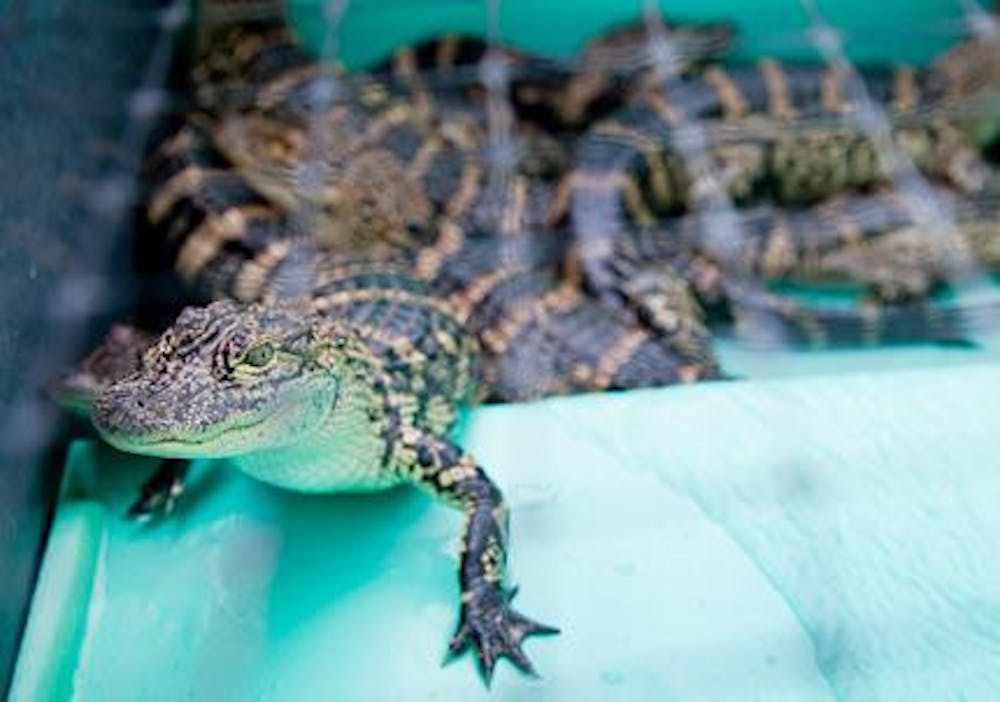Growing up in Tampa, Ph.D. candidate Ashley Boggs enjoyed Florida's wildlife and often played with lizards and turtles.
However, graduating to alligators didn't cross her mind until later, she said.
"I never thought about the bigger animals like alligators," Boggs said. "Other than canoeing down the Hillsborough River as a kid, I never really ran into them."
Boggs now studies alligator growth at the Guillette Lab at UF to assess the effect of toxins on the animals in the wild.
As an undergraduate zoology student, Boggs began volunteering in the lab where she was paired with a graduate mentor, a position she now holds.
The eggs used in her study were collected from Lake Woodruff, a relatively clean site, Lake Apopka, which is considered a contaminated area and their test site, near Kennedy Space Center in Cape Canaveral.
"Everything that the embryo needs to develop is packed into the egg by the mother," Boggs said. "We wanted to see if the mother was putting anything into the egg that might be harmful."
In particular, Boggs is curious to see what effects the space center may have on the alligators.
"[Cape Canaveral] is still fairly wild, and there's a decent sized alligator population out there. We've been looking at chemicals like flame retardants, heavy metals and perchlorate, which makes up a large part of rocket fuel," Boggs said.
According to Boggs, some of these chemicals can reduce the production of thyroid hormone, which alters metabolism and development.
High levels of perchlorate have not yet been detected in the area. The chemical has a very hot, intense burn, and most of it may be burned up during launches, with little of it escaping into the environment when the shuttle takes off, Boggs said.

(Andrew Stanfill / Alligator Staff) UF graduate student Ashley Boggs holds two young alligators that were born during the hatching season last year.
However, perchlorate may enter surrounding waterways at other points on the space center.
"We're very interested in the areas where they're washing the shuttles down afterwards or maybe where they're loading or unloading the fuel, and there might be some sort of spillage there," Boggs said.
Once the eggs were collected, Boggs' job was to make sure that all of the eggs, and the alligators hatching from them, experienced the exact same conditions.
The more than 250 alligators being studied are housed in greenhouses on the rooftops of Bartram and Carr halls. All reptiles are packed in about six tubs, which resemble the natural crowding behavior of young alligators in the wild.
Boggs records each alligator's length every two weeks, first measuring from snout to tail and again without the tail.
"This is more indicative of their actual length because tail size can vary," Boggs said.
Finally Boggs takes the weight and measures the tail girth; the size of the tail girth is generally an indication of health.
"There is a wide difference in the growth rates of these animals. Whether or not it's significant from lake to lake, we don't know yet. But just visually we know that some animals aren't doing as well as others," Boggs said.
The alligators are almost one year old, and the largest are around two feet, the smallest are less than half that size.
To prevent bias in the study, Boggs is purposely unaware of the origins of any particular alligator, however each alligator was fitted with an electronic chip so that data can be stored on a computer system.
When the study is complete, she will look at the computer and be able to match the groups of alligators with their original home.
Alligators were chosen as the subject of this study because they are a "sentinel species."
"They can tell us things about the environment. They're kind of like our watch dogs," Boggs said.
Because alligators are aquatic, any toxins in the water will end up in them. Additionally, alligators eat a lot of fish, which increases their exposure to contaminants.
The irony of a UF Gator working with alligators has not been lost on Boggs.
"It's a joke that I have to deal with a lot," she said. "Really the benefit of being in Florida is being in an environment where my study species is easily accessible."
Two of the most important things that Boggs has learned while studying alligators are confidence and respect.
"You can't hesitate and be scared when you're out there trying to catch an alligator," she said.
On the other hand, the creatures command respect.
"You just have to understand that this is a powerful animal and even though you get used to handling them, they're still wild," Boggs said.
But, Boggs sees her work extending beyond alligators.
"What we do to the environment, we're doing to ourselves as well. There's not a separation between the two; we are a part of our environment," Boggs said.






